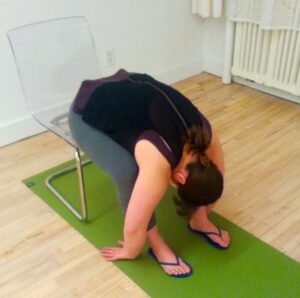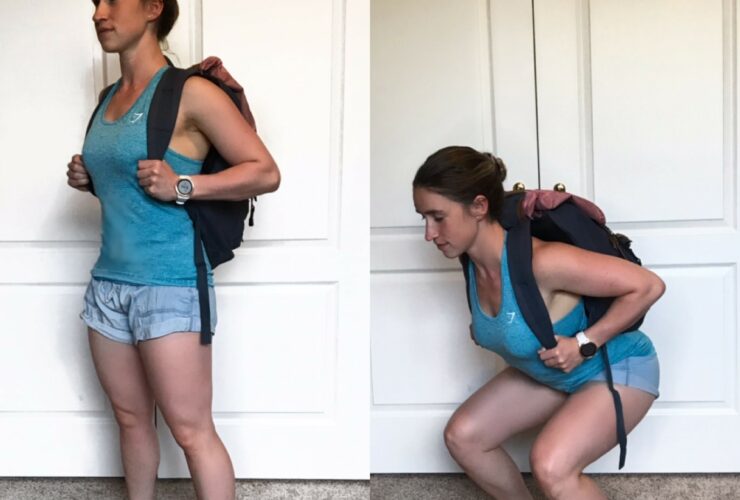Child’s Pose Stretch
Child’s Pose is known as “Balasana” in Yoga [bala= child, asana =posture].
 It’s easy to underestimate both the challenge and the opportunity of this simple pose. If you’ve been to a yoga class, you may know Child’s Pose as a resting posture – something provided as option when you need a break.
It’s easy to underestimate both the challenge and the opportunity of this simple pose. If you’ve been to a yoga class, you may know Child’s Pose as a resting posture – something provided as option when you need a break.
Labeling something as a “rest” implies that it’s easy, and Child’s Pose is not easy! Why is it not easy? There can be several challenges to this posture.
-Stiff hips and low back muscles can make it hard to lower your buttocks towards your heels
-Tight ankles can make it difficult to lay the tops of your feet flat on the floor in a weight bearing position
-A keyed up nervous system and stress response might make it very hard to be still for any length of time (i.e. you should be “doing something!” right?)
I think Child’s Pose is a great name for this position because it requires a certain humility to become a child. It’s not CEO pose, or model pose, or powerful-person pose, after all. Here’s an opportunity to let go of all your self-imposed notions of grandeur and success, and embrace a version of you that existed before the “shoulds” crept in.
If you can take a few minutes to take the shape of child’s pose you will be very rewarded. Here are some benefits:
-calming of the nervous system, which relieves stress and fatigue
-relief of tension to the back and neck musculature (especially in a supported version using blankets/bolsters)
-relief for insomnia
-a gentle circulatory enhancement to the brain/scalp (because the head is slightly lower than the heart)
A few basic instructions:
1. Kneel on the floor (ideally a carpeted surface or on a mat) with the tops of your feet on the floor. Your big toes are touching.
2. Separate your knees (a lot, or a little based on your preference and comfort)
3. Exhale and bring your torso towards your thighs with your forehead to the floor.
4. Gently tuck your chin to allow the back or your neck to lengthen.
5. Rest here while you breathe. This is an especially great position to be aware of your rib cage expanding on the inhale, and relaxing on the exhale.
6. After a minute or so, lengthen the front of your torso to come up slowly.
Some photos of child’s pose and variations.
A. “Classic”
 In a classic child’s pose, your buttocks will be lowering down toward your heels. Arms are draped alongside your body with palms up. Forehead rests on the floor.
In a classic child’s pose, your buttocks will be lowering down toward your heels. Arms are draped alongside your body with palms up. Forehead rests on the floor.
Here are some ideas: a rolled blanket between your buttocks and ankles can be very comfortable -especially, if like me, there is a gap between them. With every exhale, allow you back-body, hips and glutes to “settle down” towards the ankles. If you hang out here for a minute or so you will find that your hips have calmed down considerably.
Wider apart knees also allow your torso to fold more thoroughly towards the floor.
B. Arms out-stretched
 This can be a nice modification if you find there’s too much pressure or weight towards the forehead in the classic version. For this variation, let your arms be totally relaxed on the floor (as pictured) or more actively S-T-R-E-T-C-H them away while you keep you hips anchored down.
This can be a nice modification if you find there’s too much pressure or weight towards the forehead in the classic version. For this variation, let your arms be totally relaxed on the floor (as pictured) or more actively S-T-R-E-T-C-H them away while you keep you hips anchored down.
C. Restorative Child
 One of the most soothing positions for your body. Knees are wide apart, a rolled blanket is between heel and buttocks, and most importantly, a bolster (or thick rolled blankets) is placed on the ground for the torso to rest on completely. Your head is also supported by this bolster. Remember to alternate the rotation of your head, so both sides of the neck get a nice stretch. As you sink heavily, imaging your internal organs sinking down into the bolster, being nourished and rested.
One of the most soothing positions for your body. Knees are wide apart, a rolled blanket is between heel and buttocks, and most importantly, a bolster (or thick rolled blankets) is placed on the ground for the torso to rest on completely. Your head is also supported by this bolster. Remember to alternate the rotation of your head, so both sides of the neck get a nice stretch. As you sink heavily, imaging your internal organs sinking down into the bolster, being nourished and rested.
D. Office Child
 Who would make a poor child suffer in an office? That’s a question I can’t answer. However, when you’ve been at your desk for too long, you’ll know it because the back, neck and shoulders start to protest. Give them a bit of care by taking this chair-version of a Child’s pose.
Who would make a poor child suffer in an office? That’s a question I can’t answer. However, when you’ve been at your desk for too long, you’ll know it because the back, neck and shoulders start to protest. Give them a bit of care by taking this chair-version of a Child’s pose.
It’s easier if you sit at the very edge of the seat and allow your legs to be wide.
Let your head be completely heavy to allow the neck to relax. The shoulders, arms and hands are also allowed to be like a ragdoll. It’s especially challenging to get the neck relax. Even in the photo, I can now observe that my neck is still a little extended. If I could go back in time, I’d drop my head completely and the back of my neck would feel even better!
Hope you enjoy these postures in good health, please contact me at therapy lounge if I can help you with any questions about them.




Comments are closed.